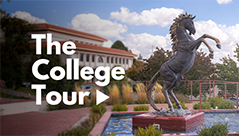Complex and delicious aromas wafted through the second floor of WNMU Harlan Hall on a recent Monday afternoon. But the seven students in Associate Professor Shiva Kyasa’s organic chemistry laboratory were not cooking up dinner; instead, they were working to identify the molecular composition of a variety of spices.
Kyasa described the project as a “Course-based Undergraduate Research Experience” (CURE). The project is one of five at WNMU that is being sponsored by the NM IDeA Networks of Biomedical Research Excellence this year.
At the beginning of the course, each student chose a spice that would be the focus of their research throughout the semester. The assignment was succinct but in no way simple: to identify the molecules that make the spice unique.
“Many people know that foods have carbohydrates and proteins and fatty acids, but food is not just those three things,” said Kyasa, “There are organic molecules. Any time you smell some aroma, it is not from carbohydrates, proteins, or fatty acids; it is from something else. So we are trying to explore those. [Students are asked to] isolate and identify these molecules.”
Kyasa said that the assignment provides an opportunity for students to learn a variety of analytical techniques and to use some of the chemistry laboratory’s sophisticated equipment that they might not otherwise have an opportunity to use. This is a tremendous benefit as students look ahead to future careers and graduate school, he said, as they will have hands-on experiences that many of their peers at other institutions may not.
While Kyasa leads the students through the various techniques they can use, the assignment is unusual because of how open-ended it is. “There is no specific procedure. There is no step-by-step,” he said.
The open-ended quality of the assignment has made it interesting, said third-year chemistry major Troy Jackson, who is analyzing cumin and caraway. The purpose, he said, was to get “experience doing a lab without set instructions … [It is about] what you can do in a lab—not just what you are told to do.”
Transfer student Anastacia Armijo, who is analyzing cloves and coriander, said she was enjoying the process. “I have never been in a lab where we have been able do research on our own,” she said, “Dr. Kyasa has made it a lot of fun. … We have a chance to play around and figure things out for ourselves. It has taught us a lot.”
Working independently on the project also appeals to third-year student Madelyn Reyes. “None of us are doing the same thing, so we don’t compare,” she said, “You do not know what to expect, and everyone’s results are different.” Reyes is analyzing a lesser-known spice, stone flower, a species of lichen that is used as a spice in India. She noted that it was rare for an undergraduate chemistry student to have a chance to work on an independent research project.
Chemistry major Shandiin Harper, who was busy grinding star anise with a mortar and pestle in the lab, said that one benefit of the course was that it instilled a lot of confidence. “I am getting super comfortable with all the different techniques we are learning,” she said.
In addition to getting the hands-on laboratory experience, the students in the class will also gain experience presenting their findings publicly by presenting their work at the Academic Student Research Symposium in April, said Kyasa.
Reyes said that while she is nervous about the public speaking component of the assignment, she is nonetheless excited to share the results of the project. “I think it will be cool to tell everyone what I have learned,” she said.
The symposium is scheduled for April 23-24 in the Miller Library and is open to the public.
Research reported in this publication was supported by an Institutional Development Award (IDeA) from the National Institute of General Medical Sciences of the National Institutes of Health under grant number P20GM103451.



